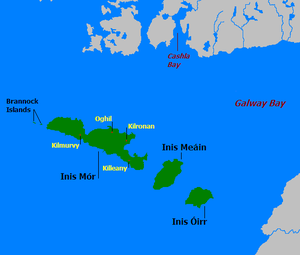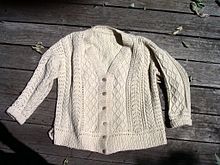Aran Islands
| Aran Islands | ||
|---|---|---|
| Typical small-scale landscape with stone walls on Inisheer | ||
| Waters | Atlantic Ocean | |
| Geographical location | 53 ° 7 ′ N , 9 ° 42 ′ W | |
|
|
||
| Number of islands | 3 bigger ones | |
| Main island | Árainn | |
| Total land area | 51 km² | |
| Residents | 1251 (2011) | |
| Detailed map of the Aran Islands | ||
The Aran Islands ( Irish Oileáin Árann [ ˌɪlɑːnʲ ˈɑːɾən̪ ], English Aran Islands ) are a group of islands off the west coast of Ireland in Galway Bay . The for County Galway islands belonging hot Árainn ([ ɑːɾən̠ʲ ] or Inis Mór [ ˌɪnɪʃ moːɾ ], anglicised Inishmore ), Inis Meáin ([ ˌɪnʲɪʃ mʲɑːnʲ ], anglicised Inishmaan ) and Inis Oírr ([ ˌɪnʲɪʃ iːɾʲ ] or Inis Oirtheach [ ˌɪnʲɪʃ ɪɾʲhəx ] , Anglicized Inisheer ).
The English spelling of the archipelago Aran Islands should not be confused with Aran Island in County Donegal or the Isle of Arran in Scotland.
geography
The total size is around 51 km². The largest island, Árainn (Inishmore), on which the places Cill Rónáin ([ ˌciːlʲ ˈɾoːnɑːnʲ ], anglis. Kilronan) and Cill Mhuirbhigh ([ ˌciːlʲ ˈwiɾʲəvʲə ], anglis. Kilmurvy ) are located, is 13 kilometers long and 3 kilometers wide. In 2011 the population was 1251, after 1225 five years earlier.
The Aran Islands are characterized by small gardens surrounded by stone walls. These gardens were laboriously laid out on the previously bare rocky islands. For this purpose, all washed up seaweed and sand were distributed on the ground. The walls prevented the soil from being washed away or blown away by the next rain or storm.
geology
The barren limestone islands geologically continue the formation of the Burren on the main Irish island.
history
About 5000 people lived on the islands in the 18th century. Today there are 1251 people who have their permanent residence on the islands (as of 2011); others work on the mainland and mostly spend the summer months on the islands.
For many years the main source of income for the residents was fishing. However, this was almost given up in the mid-1990s. In return, there were generous support payments from the European Union. Many former fishermen switched to the tourism business, opened shops, became bus drivers or ran restaurants. Many residents left the islands.
Today there is a very large age gap. There are around 80 students on the island. Many of them leave home after their 18th birthday and do not come back due to a lack of jobs. As a result, the majority of the population is over 50 years old and the number of residents is steadily declining.
Culture
In Inishmaan and Inisheer, Irish , a form of Gaelic , is the main language of the residents.
The Aran Islands are known for the local people's knitwear. The costume of women consists of a red flannel skirt and a crochet cloth, that of men consists of a sleeveless tweed jacket and a colorful wool belt. For a long time, the traditional means of transport between the islands was the curragh , a flat boat made of tarred canvas, which is hardly used today .
The culture of the Aran Islands, especially the use of Gaelic, continues to attract many visitors to this day. The writer John Millington Synge lived in and wrote about the Aran Islands from 1899 to 1902. The documentary filmmaker Robert J. Flaherty shot the film The Men of Aran there from 1932 to 1934 .
economy
Today agriculture, manufacture and trade in textile articles as well as expanding tourism are the main sources of income for the residents. Fishing, which was the main source of income for the inhabitants in the last decades, only plays a subordinate role today, as the islands ceded their fishing rights to the European Union (EU) in the mid-1990s. In return, the islands received subsidies from the EU.
Inishmore offers bus tours for tourists. The island can also be explored by bike. Cross-country hikes are difficult because of the many stone walls.
The islands owe part of their fame to the film Man of Aran , which Robert J. Flaherty directed in 1934. It is considered to be one of the first ethnographic documentary films. There are numerous depictions of the Aran Islands in Irish and Anglo-Irish literature, particularly from the Irish Renaissance period, such as John Millington Synges The Aran Islands or his play Riders to the Sea . The Aran Islands are also mentioned in Nik Kershaw's pop song The Riddle .
Aran sweater
The islands gave the Aran Sweater their name. These traditional sweaters were initially made exclusively by hand on the Aran Islands. During the 20th century they became famous and were exported not only to mainland Ireland but worldwide. Therefore most sweaters were made by machine from now on.
Today, a small percentage of the knitting is still done by hand on the Aran Islands. They are popular with tourists and are a good source of income for the residents of the Aran Islands.
Infrastructure
The main island consists of a main town and 13 other settlements. A road network opens up the island. It has a supermarket, post office, bank, three churches, three primary schools and a secondary school. There are also plenty of accommodation options and there are plenty of pubs and restaurants.
There are only diesel powered vehicles on Inishmore. Until 1975 there was no electricity.
All three islands each have an asphalt runway. You are regularly served by Aer Arann Islands .
Attractions
The most important sights of the islands are the numerous prehistoric testimonies as well as the traces of the monastic tradition that originated from the Christianization by Saint Enda in the 5th century.
Worth seeing are:
- Inishmore
- Clochán na Carraige - the only preserved beehive hut on the islands
- Dun Aengus , or Dún Aonghasa , stone fort from the Bronze or Iron Age
- Dún Dúchathair ( Dun Doocaher , German: "The Black Fort") - Promontory Fort
- Dún Eochla - ring fort near the highest point on Inishmore Island
- Dún Eoghanachta - Ring Fort on Inishmore
- Poll na bPéist - perfectly rectangular, natural water basin
- the small town of Cill Rónáin on Inishmore with the Aran Heritage Center
- Na Seacht dTeampaill (German: "The seven churches") - former monastery
- Teampall Chiaráin - church ruins from the 12th century
- Inishmaan
- Dún Chonchúir on Inishmaan stone fort from the Iron Age
- Dún Fearbhaí Ringfort
- Wedge Tomb by Carrownlisheen
- Inisheer
- Dún Formna , remains of a ring fort with O'Brien's Castle
traffic
The Aran Islands are accessible by ferry from Galway City , Rossaveal in Connemara and Doolin in County Clare . There are also Aer Arann Islands flights from Connemara Airport to all three islands.




